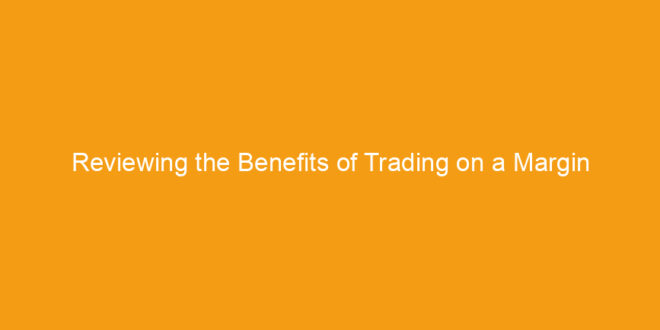Trading on a margin platform is an increasingly popular form of investing. It involves a practice of utilizing borrowed funds to increase potential returns on investments. It has become a popular tool for traders, as it can often deliver higher returns than traditional trading methods.
The primary benefit of trading on a margin platform is the ability to increase potential returns on investments. By leveraging the borrowed funds, traders are able to make larger investments than they would be able to make with their own capital. This can lead to higher returns, as traders are able to take advantage of larger gains when the market is trending positively.
Another benefit of trading on a margin platform is the ability to reduce risk. By leveraging borrowed funds, traders are able to spread their investments over a larger range of assets. This enables them to reduce the overall risk associated with their portfolio, as they are no longer reliant on any single asset.
Finally, trading on a margin platform can also provide traders with greater flexibility. By leveraging the borrowed funds, traders can adjust their investments quickly and easily in order to take advantage of market conditions. This allows them to shift their investments in order to capitalize on any sudden changes in the market.
Overall, trading on a margin platform is a powerful tool for traders. It can provide traders with increased returns and reduced risk, as well as greater flexibility. As such, it is an attractive option for those looking to maximize their returns in the markets.
Understanding the Different Types of Margin Trading Platforms
Margin trading is a form of trading in which an investor borrows money from a broker or a financial institution to buy stocks or other assets. It is a way to increase leverage and consequently, the potential returns on an investment. While margin trading can be a powerful tool for active traders, it carries significant risk and requires careful consideration.
To help manage risk, investors can use various types of margin trading platforms. Each type of platform offers different features, enabling traders to select the best platform for their individual strategies.
One type of margin trading platform is the margin account. This type of account allows traders to borrow money from a broker to purchase stocks or other assets. Traders can use the borrowed money to increase their buying power and consequently, their potential returns on an investment. Margin accounts also typically provide some form of leverage, allowing traders to increase their profits without having to commit more capital.
Another type of margin trading platform is the futures margin account. This type of account is used by traders who are interested in buying and selling futures contracts. Futures contracts are long-term agreements to buy or sell an asset at a certain price on a certain date. Traders can use the money borrowed from the broker to purchase futures contracts and use the leverage to increase their profits.
Finally, there are options margin accounts. In this type of account, traders can borrow money from a broker to purchase options contracts. Options contracts give traders the right, but not the obligation, to buy or sell an asset at a certain price by a certain date. By using the leverage from the options margin account, traders can increase their potential profits without having to commit more capital.
Margin trading can be a powerful tool for active traders, but it carries significant risk. Therefore, it is important for investors to understand the different types of margin trading platforms and select the best one for their individual strategies. By understanding the features of each type of platform, traders can make informed decisions and manage their risk more effectively.
Comparing Popular Margin Trading Platforms: Pros and Cons
Margin trading is a popular trading strategy used by both amateur and experienced traders alike. It allows traders to open positions with borrowed funds from their broker, effectively leveraging their capital and increasing their potential gains and losses on any given trade. With so many margin trading platforms available to traders, it can be difficult to know which one is right for you. In this article, we will discuss the pros and cons of the most popular margin trading platforms so that you can make an informed decision about which one is best for your trading needs.
Pros of eToro
eToro is one of the most popular margin trading platforms. It offers traders the ability to open positions with up to 2x leverage on major currency pairs, indices, and commodities. In addition, traders can access the CopyTrader feature, which allows them to copy the trades of successful traders, thereby reducing the learning curve associated with margin trading. Furthermore, eToro offers a user-friendly interface and a wide range of educational resources.
Cons of eToro
eToro’s fees are relatively high compared to other margin trading platforms, and the maximum leverage offered is limited to 2x. In addition, the CopyTrader feature can be a double-edged sword, as it can lead to traders taking greater risks than they should. Finally, eToro does not offer access to other asset classes such as cryptocurrencies and stocks.
Pros of AvaTrade
AvaTrade is another popular margin trading platform. It offers up to 400x leverage on major currency pairs, indices, commodities, and cryptocurrencies. In addition, the platform provides a user-friendly interface and a wide range of educational resources to help traders learn the ropes of margin trading.
Cons of AvaTrade
AvaTrade’s fees are relatively high compared to other margin trading platforms, and the platform does not offer access to stocks. Furthermore, the platform’s maximum leverage of 400x can be a double-edged sword, as it can lead to traders taking greater risks than they should.
Ultimately, the decision of which margin trading platform is right for you will come down to your individual trading needs and preferences. Be sure to consider the pros and cons of each platform before making your decision.

